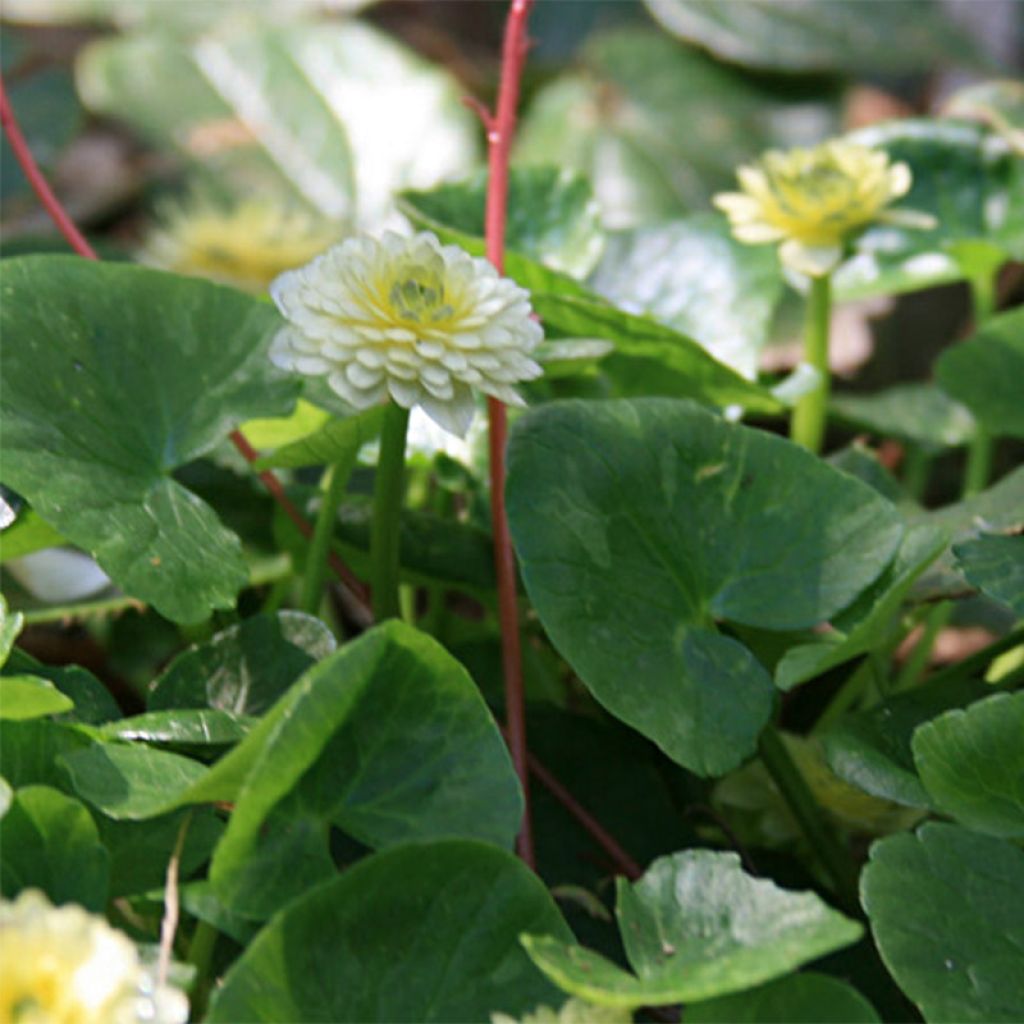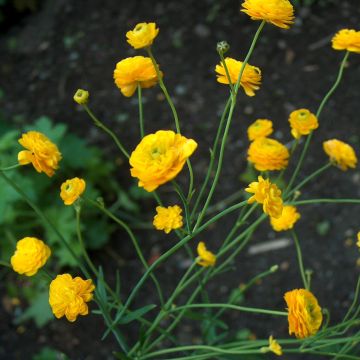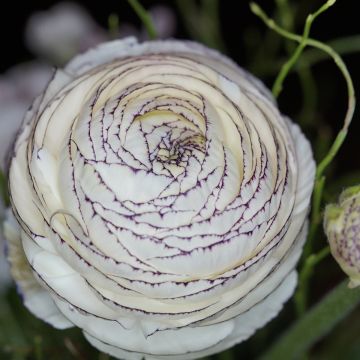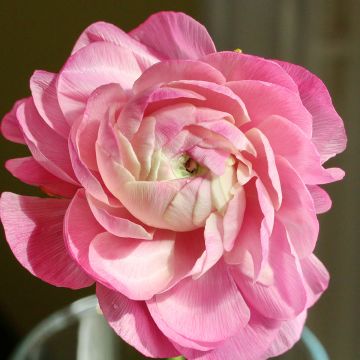

Ranunculus ficaria Ken Aslet - Ficaire
Ranunculus ficaria Ken Aslet - Lesser Celandine
Ranunculus ficaria Ken Aslet
Lesser Celandine, Fig Buttercup, Pilewort
Why not try an alternative variety in stock?
View all →This plant carries a 6 months recovery warranty
More information
We guarantee the quality of our plants for a full growing cycle, and will replace at our expense any plant that fails to recover under normal climatic and planting conditions.
From €5.90 for pickup delivery and €6.90 for home delivery
Express home delivery from €8.90.
Does this plant fit my garden?
Set up your Plantfit profile →
Description
The Ranunculus ficaria Ken Aslet (Lesser Celandine) is a low-growing herbaceous plant (10 to 20 cm (4 to 8in)) that is ideal as ground cover for shady areas. It produces star-shaped flowers in a beautiful bright yellow from March onwards. It is a spreading plant that propagates quickly, disappearing in the summer and re-emerging in winter. Plant in spring for flowering from March to April.
The lesser celandine or pilewort is a perennial herbaceous plant belonging to the Ranunculaceae family. It is a common species in woodlands, damp meadows, or along streams, below 1600m (5249ft) altitude. The lesser celandine is sometimes considered invasive, but its ground-covering flowers that appear as soon as winter ends are of such a bright yellow that it quickly finds its place in the garden.
The lesser celandine is a low-growing plant, 10 to 20 cm (4 to 8in) tall, with the peculiarity of being dormant during the summer and reemerging in winter. Heart-shaped leaves appear in January. Flowering occurs from March onwards. The star-shaped flowers are a beautiful bright yellow, with 3 sepals and 6 to 12 petals. They close in overcast weather. The lesser celandine produces small tubercles that can be transformed into a ointment to treat hemorrhoids, hence the name 'herb of hemorrhoids' sometimes used. The leaves and tubercles are slightly toxic, especially if eaten raw. The name 'celandine' is derived from the shape of the tubercles, resembling that of figs (ficus in Latin). The fruits of the lesser celandine are achenes, but the plant primarily multiplies through tubercles or bulbils located in the axils of the leaves.
In the garden, the lesser celandine prefers shaded areas. It will be ideal as ground cover to brighten up a dark corner with its vibrant flowers.
Report an error about the product description
Ranunculus ficaria Ken Aslet - Lesser Celandine in pictures




Plant habit
Flowering
Foliage
Botanical data
Ranunculus
ficaria
Ken Aslet
Ranunculaceae
Lesser Celandine, Fig Buttercup, Pilewort
Cultivar or hybrid
Other Ranunculus - Buttercup
Planting and care
The young plant is planted in spring, preferably around February. It thrives in ordinary soils with a tendency for moisture. Place it in a shaded area, at the base of a hedge or along the edge of a flower bed for example.
Dig a hole and then place the young plant and cover it with soil.
The young plant does not require any particular maintenance. It can remain in the soil and will sprout again during the following winter.
Planting period
Intended location
Care
This item has not been reviewed yet - be the first to leave a review about it.
Haven't found what you were looking for?
Hardiness is the lowest winter temperature a plant can endure without suffering serious damage or even dying. However, hardiness is affected by location (a sheltered area, such as a patio), protection (winter cover) and soil type (hardiness is improved by well-drained soil).

Photo Sharing Terms & Conditions
In order to encourage gardeners to interact and share their experiences, Promesse de fleurs offers various media enabling content to be uploaded onto its Site - in particular via the ‘Photo sharing’ module.
The User agrees to refrain from:
- Posting any content that is illegal, prejudicial, insulting, racist, inciteful to hatred, revisionist, contrary to public decency, that infringes on privacy or on the privacy rights of third parties, in particular the publicity rights of persons and goods, intellectual property rights, or the right to privacy.
- Submitting content on behalf of a third party;
- Impersonate the identity of a third party and/or publish any personal information about a third party;
In general, the User undertakes to refrain from any unethical behaviour.
All Content (in particular text, comments, files, images, photos, videos, creative works, etc.), which may be subject to property or intellectual property rights, image or other private rights, shall remain the property of the User, subject to the limited rights granted by the terms of the licence granted by Promesse de fleurs as stated below. Users are at liberty to publish or not to publish such Content on the Site, notably via the ‘Photo Sharing’ facility, and accept that this Content shall be made public and freely accessible, notably on the Internet.
Users further acknowledge, undertake to have ,and guarantee that they hold all necessary rights and permissions to publish such material on the Site, in particular with regard to the legislation in force pertaining to any privacy, property, intellectual property, image, or contractual rights, or rights of any other nature. By publishing such Content on the Site, Users acknowledge accepting full liability as publishers of the Content within the meaning of the law, and grant Promesse de fleurs, free of charge, an inclusive, worldwide licence for the said Content for the entire duration of its publication, including all reproduction, representation, up/downloading, displaying, performing, transmission, and storage rights.
Users also grant permission for their name to be linked to the Content and accept that this link may not always be made available.
By engaging in posting material, Users consent to their Content becoming automatically accessible on the Internet, in particular on other sites and/or blogs and/or web pages of the Promesse de fleurs site, including in particular social pages and the Promesse de fleurs catalogue.
Users may secure the removal of entrusted content free of charge by issuing a simple request via our contact form.
The flowering period indicated on our website applies to countries and regions located in USDA zone 8 (France, the United Kingdom, Ireland, the Netherlands, etc.)
It will vary according to where you live:
- In zones 9 to 10 (Italy, Spain, Greece, etc.), flowering will occur about 2 to 4 weeks earlier.
- In zones 6 to 7 (Germany, Poland, Slovenia, and lower mountainous regions), flowering will be delayed by 2 to 3 weeks.
- In zone 5 (Central Europe, Scandinavia), blooming will be delayed by 3 to 5 weeks.
In temperate climates, pruning of spring-flowering shrubs (forsythia, spireas, etc.) should be done just after flowering.
Pruning of summer-flowering shrubs (Indian Lilac, Perovskia, etc.) can be done in winter or spring.
In cold regions as well as with frost-sensitive plants, avoid pruning too early when severe frosts may still occur.
The planting period indicated on our website applies to countries and regions located in USDA zone 8 (France, United Kingdom, Ireland, Netherlands).
It will vary according to where you live:
- In Mediterranean zones (Marseille, Madrid, Milan, etc.), autumn and winter are the best planting periods.
- In continental zones (Strasbourg, Munich, Vienna, etc.), delay planting by 2 to 3 weeks in spring and bring it forward by 2 to 4 weeks in autumn.
- In mountainous regions (the Alps, Pyrenees, Carpathians, etc.), it is best to plant in late spring (May-June) or late summer (August-September).
The harvesting period indicated on our website applies to countries and regions in USDA zone 8 (France, England, Ireland, the Netherlands).
In colder areas (Scandinavia, Poland, Austria...) fruit and vegetable harvests are likely to be delayed by 3-4 weeks.
In warmer areas (Italy, Spain, Greece, etc.), harvesting will probably take place earlier, depending on weather conditions.
The sowing periods indicated on our website apply to countries and regions within USDA Zone 8 (France, UK, Ireland, Netherlands).
In colder areas (Scandinavia, Poland, Austria...), delay any outdoor sowing by 3-4 weeks, or sow under glass.
In warmer climes (Italy, Spain, Greece, etc.), bring outdoor sowing forward by a few weeks.















































